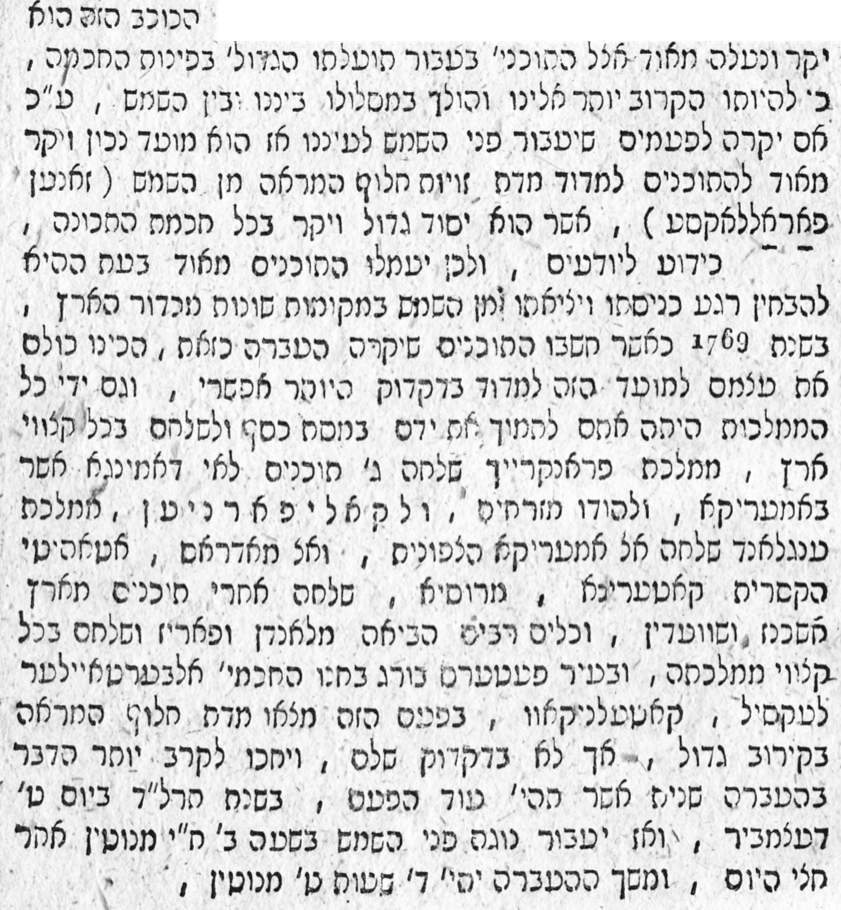The Second Temple in Jerusalem. On the right are the three northern gates into the courtyard. From front to back they are The Women’s Gate (שער הנשים), The Gate of the Offering (שער הקרבן), and The Gate of the Ray (שער הניצוץ).
In tomorrow’s page of Talmud, we read the following Mishnah that describes the architecture of the Temple in Jerusalem.
מדות לד, א
שִׁבְעָה שְׁעָרִים הָיוּ בָעֲזָרָה, שְׁלשָׁה בַצָּפוֹן וּשְׁלשָׁה בַדָּרוֹם וְאֶחָד בַּמִּזְרָח. שֶׁבַּדָּרוֹם, שַׁעַר הַדֶּלֶק. שֵׁנִי לוֹ, שַׁעַר הַבְּכוֹרוֹת. שְׁלִישִׁי לוֹ, שַׁעַר הַמָּיִם. שֶׁבַּמִּזְרָח, שַׁעַר נִקָּנוֹר, וּשְׁתֵּי לְשָׁכוֹת הָיוּ לוֹ, אַחַת מִימִינוֹ וְאַחַת מִשְּׂמֹאלוֹ, אַחַת לִשְׁכַּת פִּנְחָס הַמַּלְבִּישׁ, וְאַחַת לִשְׁכַּת עוֹשֵׂי חֲבִתִּין
There were seven gates in the courtyard [of the Temple the stood in Jerusalem]: three in the north and three in the south and one in the east. In the south: the Gate of Kindling, and next to it the Gate of the First-borns, and then the Water Gate. In the east: the Gate of Nicanor. It had two chambers, one on its right and one on its left. One was the chamber of Pinchas the dresser and one the other the chamber of the griddle cake makers.
The Temple was not only the physical resting place of God on earth. It was also a model of the universe itself, and built into it was the very structure of our solar system. Here’s how.
Rabbi Moses Isserles: Halachist and Astronomer
For Ashkenazi Jews who practice their faith, perhaps the most important figure is Rabbi Moses Isserles (d. 1572). R. Isserles, better known by his acronym as the Rema, earned this accolade because of his gloss on the Shulhan Arukh, the code of Jewish law, which had been written by a Sephardic Jew, Joseph Caro (d. 1575). Caro’s magnum opus was the defining code of Jewish law, but it had a serious deficiency in that it lacked the customs and rulings of the Ashkenazi Jews of Germany and Poland. Moses Isserles redressed this defect by writing a commentary and supplement for the Ashkenazi Jews, and as a result the Shulhan Arukh with Isserles’ gloss became the authoritative code and guide for all Polish-German Jews. The Shulhan Arukh was first published in Venice in 1565 and went through six editions in Caro’s lifetime alone, with Isserles’ gloss becoming the authoritative reference work for Ashkenazi Jews.
But the Rema’s scholarship was not limited to the vast field of Jewish law, and he was deeply interested in astronomy. He wrote a commentary on the Hebrew translation of Georg Peuerbach’s Theoricae Novae Planetarum (New Theories of Planets), which had been published in 1473. He also wrote a more esoteric work of astronomy entitled Torat Ha’olah (The Laws of the Burned Sacrifice), in which he demonstrated how the Temple in Jerusalem symbolized a wide range of astronomical phenomena. The Rema claimed that there was a direct numerical relationship between the Temple and these phenomena, and he wove together a wide range of earlier rabbinic sources and non-Jewish astronomers to prove his thesis. For example, he wrote that the altar of the Temple corresponded to the layout of the heavens, and that the seven gates leading into the temple corresponded to the seven planets.
The Azarah [the large courtyard in the Temple] was a reflection of the World of the Spheres as we have explained, which is why they stated that it had seven gates, which represented the seven planets, Saturn, Jupiter, Mars, the Sun, Venus, Mercury and the Moon. For each of these planets has its own gate in its own particular path, and the path of one is not like the path of another. Three of the gates in the Temple are on the left and three on the right, representing the three planets to the right of the sun which are the major ones. These are hinted to in the gates on the east, as I will explain. And the three gates to the left represent the three planets to the left of the Sun which stands in the middle, like a king in the middle of his soldiers. And in truth this fact has persuaded the astronomers to believe that the sun is at the center of all the stars [Torat Ha’olah 12b].
Philo: The Menorah was also a Model of the Solar System
The Rema was following a long tradition of ascribing allegorical meaning to the Temple and its various contents. Perhaps the earliest to do so was Philo of Alexandria, a Jewish biblical commentator who lived in the first century. He wrote of the allegorical meaning of the menorah, the seven-branched candelabrum that was placed in the Tabernacle and later in the Temple in Jerusalem:
[F]rom this candlestick there proceeded six branches, three on each side, projecting from the candlestick in the center, so as altogether to complete the number of seven; and in all the seven there were seven candles and seven lights, being symbols of those seven stars which are called planets by those men who are versed in natural philosophy; for the sun, like the candlestick, being placed in the middle of the other six, in the fourth rank, gives light to the three planets which are above it, and to those of equal number which are below it, adapting to circumstances the musical and truly divine instrument.
The menorah as symbol of the order of the planets from the Earth. From here. Don’t be confused - this is not a model of the heliocentric solar system. Rather, the sun is the fourth of seven ‘planets’ from Earth, so it is in the middle.
The famous Spanish commentator Isaac ben Moses Arama (c. 1420–1494) also described the Menorah as a model of the solar system, in his commentary on the Torah called Akedat Yitzhak (The Binding of Isaac). It is fascinating to read see how Arama weaved the Ptolemaic geocentric system into his allegorical interpretation of the menorah, echoing Philo’s commentary:
The Sun is the central branch, for it is that which is required to lead all the others. [The three branches on each side represent] the three planets, three on one side and three on the other, which serve to help and support the perfection of one’s intentions. . . .
It is easy to mistakenly read Arama’s allegorical interpretation as placing the Sun at the center of the solar system, but this is not what he described. Rather, Arama outlined the order of the planets of the Ptolemaic system. These were the seven planets in the order in which they orbited the Earth, with the Moon closest and Saturn furthest away, as shown in the figure above.
Allegory is re-interpreted…allegorically
Although Isaac Arama’s interpretation would have been understood in the early-fifteenth-century pre-Copernican world, this allegory made no sense if the Sun was not the fourth planet of seven presumed to be orbiting the Earth. Hayyim Yosef Pollak, a nineteenth-century rabbi who wrote a commentary onAkedat Yitzhak, noted this problem. Pollak paraphrased Arama’s explanation in a post-Copernican way:
The six branches that come out from the sides hint at the six types of partial wisdom [contained in the Torah] that help to complete the main type of wisdom [represented by the central branch]. . . . You can also imagine the Sun is the largest and most central of the planets, and around it orbit the other six planets. . . .
Although both Arama and Pollak interpreted the central branch of the menorah as allegorically representing the Sun, their cosmology was completely different. Pollak’s interpretation is not in fact what Arama had originally written, leading to the curious, if not entirely unexpected, situation of an allegorical explanation itself being interpreted allegorically.
The Menorah and the Catholic Church
A similar exegesis was made by a Carmelite priest from Calabria in southern Italy, Paolo Antonio Foscarini, in a letter that he wrote in 1615. Foscarini’s goal was to demonstrate how the Bible could be reconciled with the new Copernican model. In the letter Foscarini suggested that the six branches of the Menorah found in the Temple corresponded to the six “heavens,” or planets, that orbit the Sun.
And could it not be that, in the marvelous structure of the candlestick placed in the Tabernacle of God, our most loving God wished to represent secretly to us the system of the universe and in particular of the planets?…it could be that these branches signify the six heavens which rotate around the sun as follows. Saturn, which is the slowest and furthest away, completes its path around the sun through all twelve signs of the zodiac in thirty years; Jupiter, which is closer, in twelve years; Mars, which is closer still, in two years. The earth, which is closer than that, moves through its path together with the orb of the moon in one year, i.e twelve months. Venus, which is still closer than all of these, in nine months. Finally Mercury, which is closest of all to the sun, in less than three months…
Having described the six branches, the Sacred Text goes on to discuss the cups, the small globes and the flowers [that adorned the branches of the Menorah]…Could it be that these three cups…are intended to signify globes (like our own earth)…? More precisely, could it be that they signify those globes [i.e moons] discovered by the telescope which are associated with Saturn, Jupiter Venus and perhaps other planets…
Alas, the letter (“Concerning the Opinion of the Pythagoreans and Copernicus About the Mobility of the Earth and the Stability of the Sun”) didn’t get a wide readership. It was was placed on the Index of Forbidden Books in March 1616 as “completely prohibited and condemned.”
The Second Temple in Jerusalem was a spectacular building, and its loss is still mourned in our daily prayers. So the next time you gaze up at the starry night, pause for moment to reflect on the grandeur of what once was.
Vincent van Gogh painted Starry Night in 1889 during his stay at the asylum of Saint-Paul-de-Mausole. From the collection of the Museum of Modern Art, New York.
[Much of this post is based on New Heavens and a New Earth: The Jewish reception of Copernican Thought.]



















